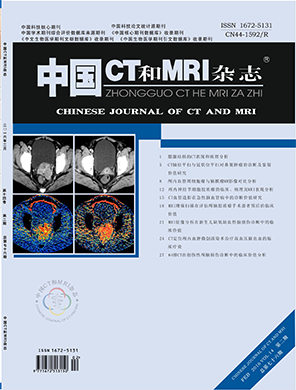论著-头颈部
头颈CTA联合扫描及脑灌注成像(CTP)在短暂性脑缺血发作(TIA)的价值*
作者:吴凯宏 肖格林 余水全 李水连 刘 峰 杨伟聪 高 雅
所属单位:广东省中山市中医院放射科(广东 中山 528400)
PDF摘要
目的评价MSCT平扫、头颈CTA以 及颅脑灌注(CTP)对TIA患者的应用价值。 方法 选取符合临床诊断标准的TIA患者30 例,所有病例均进行头颈CT平扫、CTA扫 描,颅脑CTP成像,获得相关图像数据。 结果 本组椎基动脉系统TIA共10例,其 中8例CTP脑灌注异常,CTA发现7例有椎基 动脉粥样斑块和管腔狭窄。颈内动脉系统 TIA共20例,其中15例CTP脑灌注异常, CTA发现14例有颈内动脉系统粥样斑块并 血管狭窄。结论 通过64层螺旋CT及时而 方便地检查出头颈动脉狭窄或闭塞的存在 及斑块性质,并分析软斑块发生的相关性 因素,了解相应脑血流动力学改变,不仅 能预测卒中风险,对TIA患者的早期发现 及后续的治疗有非常重要的临床意义。
Objective To evaluate the application value of MSCT scan, head and neck CTA and cerebral perfusion (CTP) in patients with TIA. Methods 30 cases meeting the standards of TIA clinical diagnosis were involved in this study, in which all patients underwent head and neck CT scan, CTA scan and cerebral perfusion imaging (CTP) to obtain the imaging data. Results Eight patients in ten cases with TIA related to the vertebral basal artery system, were detected with cerebral perfusion abnormalities, while seven patients with atheromatous plaques and luminal stenosis in CTA. 15 patients in 20 cases with TIA related to the Internal carotid artery system were detected with cerebral perfusion abnormalities and 14 patients were detected with atheromatous plaques and luminal stenosis in CTA. Conclusion With the help of 64-layer spiral CT we can quickly discover the stenosis or block in the arterys of head and neck, analyize the correlation factors of soft plaques, and get further information about the cerebral hemodynamic changes. We think that it has great clinical significance not only in predicting the risk of stroke, but also in early diagnosis of TIA patients and their following treatment.
【关键词】MSCT;脑灌注成像;短暂性脑 缺血发作;CT血管成像
【中图分类号】R445.3;R743.3
【文献标识码】A
【DOI】 10.3969/j.issn.1672- 5131.2015.12.011
前言
短暂性脑缺血发作(TIA)是临床神经内科比较常见的脑血管病, 这主要是头颈动脉管腔的狭窄、闭塞或血流动力学的改变等使局部缺 血造成的短暂性脑或视网膜的神经功能障碍。根据累及的动脉血管的 不同,表现出相应的症状和体征,其中以反复发作的短暂性失语、瘫 痪或感觉障碍为主要的特点,症状和体征多在数分钟或数小时得到恢 复,最长不超过24小时[1]。伴随着国内外众多学者及研究人员对脑血 管病变的不断研究及实践,TIA越发受到临床医师的重视。早期的诊断 及正确的治疗干预现已公认为最为重要的一环。同时,CTA不仅能发现 动脉的狭窄,并可多角度观察血管内外的结构,简单直观明了。目前 对TIA的诊断主要依靠症状体征,普通头颅CT和MRI常无阳性发现。现 整理收集2013年7月1日至2014年6月31日在我院门诊或住院部因TIA症 状就诊的患者30例,所有病例均进行头颈CT平扫、CTA扫描,用以评价 TIA患者血流动力学变化,探讨64排灌注成像及血管成像对TIA的诊断 价值。
中国CT和MRI杂志
第14卷, 第 2 期
2016年02月

相关文章